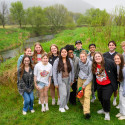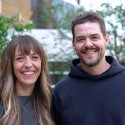Percussionist returns to alma mater with a Danish beat
When Neeraj Mehta heads out to perform, the experience can seem like a cross between “America’s Got Talent” and American Pickers.

As an undergraduate here a decade ago, Neeraj Mehta developed his passion for exploration. Now he has embarked on a concert tour that brings new works to the universities he visits.
Mehta, a percussionist who recently returned from a Fulbright fellowship in Denmark, relies on a motley stew of instruments and equipment. He calls ahead to secure a five-octave marimba or a bass drum, part of the standard setup most university concert halls have in place. Then he packs his van full of — well, everything else. A set of Afro-Cuban congas might not be so hard to find, but a Balinese ceng-ceng carved in the shape of a turtle?
His stage might be stripped bare or crammed with cymbals, lights, jungle-gym-like structures with hanging gongs, remnants of ancient cultures used in modern ways. He whirls in a space free from limits of culture or time, starting with a jazz riff and moving to a rhythmic drum chant or minimalist ostinato.
“I have that collector’s sensibility of being really interested in great sound,” says Mehta. “That’s where we come from as percussionists: our curiosity in great sounds from our own cultures and others. It drives us to perform, compose and collect.”
Mehta’s journey has come full circle with his return to UW–Madison. As an undergraduate here a decade ago, he studied with associate professor Tony Di Sanza and developed his passion for exploration. Now, as he finishes his doctorate at the University of Michigan in Ann Arbor, he has embarked on a concert tour that brings new works to the universities he visits — and brings him closer to a full-time professional career.
Unlike most other musicians, percussionists build skills on many instruments at once. A string performer might use similar techniques to play a 20th century concerto on a cello and a 16th century sonata on a viola da gamba. A percussionist, however, might use anything from rumbling timpani to a crackling paper bag. Using hands, feet, mallets, sticks, bells and just about anything else, a percussionist unites techniques not just from a few centuries of European influence but from a global expression of joyful noise.
“The heartbeat embodies the sense of rhythm and music,” says Mehta. “That’s the heart of what we do; it spans percussion around the world.”
Because of this cross-pollination, a percussion concert might feature multiple cultures converging in one piece. Mehta uses the ceng-ceng, for example, in the same composition that includes an Afro-Cuban conga drum and technique. Usually used as part of a gamelan setup for traditional Indonesian music, the ceng-ceng finds new life, in turn, in works by the composers he met in Denmark.
After finishing his master’s degree at Michigan, Mehta wanted to explore life and music outside of the United States. Under Di Sanza’s tutelage, Mehta had performed several works by the Danish composer Per Nørgård and percussionist Gert Mortensen. Now, he wanted to explore the reasons why these musicians had been able to create such a unique repertoire within such a small country.
“I thought, ‘How cool would it be to actually work with Gert Mortensen and really understand why there’s such a strong synergy around percussion?’” says Mehta. “Denmark is the size of Vermont and New Hampshire combined, but all of these composers write great stuff. It made me wonder why.”
In the 1960s and 1970s, Denmark’s Ministry of Culture had funded a group of percussionists and composers to continually return, play, participate and collect instruments in Bali and bring them back. The shared experiences between these classically trained composers generated a unique chamber and solo repertoire.
In some ways, this tour serves as a continuation of the Danish composers’ own journey, as Mehta is excited to continue the tradition of bringing new music back home. His concert puts an American spotlight on lesser-known works by these Danish masters, many of which remain unheard on this side of the Atlantic.
“A lot of the works I came across by happenstance. Gert Mortensen recommended some; I hung out in the library and picked out others that appealed to me,” says Mehta. “There were definitely advantages of a small country; hanging out with a composer like Ole Buck was as easy as shooting off an e-mail and taking a short train ride.”
Mehta’s tour takes him to several Midwestern universities near his current home base of Ann Arbor. After starting at Ohio University in Athens, he went on to the University of Akron and then Eastern Michigan. On this leg of the tour, he will continue from Madison to UW–Stevens Point, UW–Milwaukee and Lawrence University in Appleton before finishing at Northern Illinois in DeKalb.
The tour, conceived with the help of Mehta’s friend and mentor Di Sanza, is a chance to do many things. In addition to sharing the Danish repertoire, it allows Mehta to get his name out in the world of percussion while seeing how other schools teach and collaborate.
As he finishes his DMA, he knows that his studies have just begun.
“You have to approach percussion knowing that you can’t know it all and play it all,” says Mehta. “The vastness gives us humility.”




